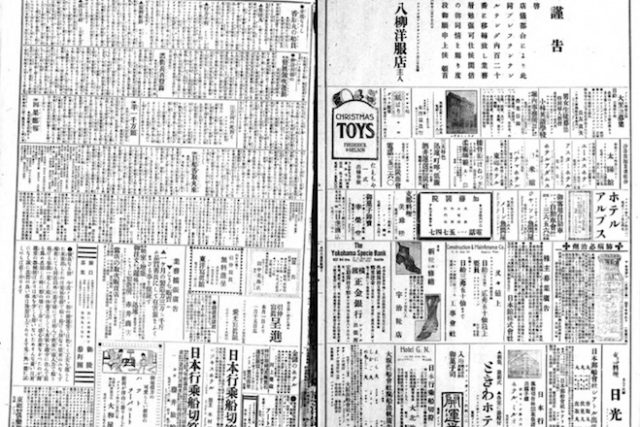A place to share information is part of an indispensable building block for the formation of immigrant communities. Today, various mediums serve as information transmitters that help support communities. In the early 20th century when Seattle’s Japanese American society was being formed, Japanese-language newspapers had substantial influence as the foremost source of information for Japanese immigrants.
The Japanese community saw tremendous growth around 1900 with the transfer of the Consulate office from Tacoma to Seattle, and the opening of a new shipping route by Nippon Yusen K.K. Numerous Japanese-language newspapers and magazines have been launched in parallel with the growth of the Japanese -American community since the late 1890s.
Among those, Hokubei Jiji had the greatest reach, with bureaus in Yakima and Spokane to serve the Japanese- American communities in the greater Pacific Northwest, not limited to the Puget Sound area.
According to Sumisato Arima, author of Shiatoru nikkan hojishi no 100-nen, Hokubei Jiji was reputed to be a paper with “high aspirations,” a hard-nosed news outfit without any leanings toward gossip news. The paper was staffed with some distinguished individuals. Kiyoshi Kiyosawa, a diplomat before the Second World War, was a journalist for the paper’s Tacoma bureau.
The paper launched September 1, 1902, as the country’s third Japanese- American newspaper. Founded by Kiyoshi Kumamoto and investors, the paper’s headquarters was located in what is today’s Nihonmachi. At the time of its launch, the paper had six pages, which would become eight by 1905. For the New Year’s edition of the following year, the paper expanded to 32 pages, with a circulation of 5,000 copies.
In 1913, the Arima family, which was central to the paper’s publication, took over management. The paper now had correspondents in Portland, Los Angeles, San Francisco, Spokane, Vancouver and Tokyo, running 6,000 copies. It also added English sections in 1918 and from then on continued enjoying a great print run.
Before U.S.-Japan relations further deteriorated during the Second World War, most members of the Arima family chose to return to Japan. The remaining Arima, Sumio, took over the paper’s publication, but when war broke out between Japan and the U.S., he was arrested by the FBI. Without a leader, the paper’s staff pulled together to continue transmitting stories amid growing tensions within the Japanese-American society. Perhaps the paper came under inspection; the English-language part was moved to the front page and the Japanese- language section started from the second page. Underneath the Japanese-language section was a company announcement, seeking support for the continuation of the newspaper.
The paper was discontinued on March 14, 1942. The newspaper published 12,278 issues over 39-and-a-half years at the center of Japanese-American immigrant communities during turbulent times. According to the Seattle Times then, the paper had a circulation of 9,000, which surpassed the population of Seattle’s Japanese-Americans. It had approximately 50 employees. Some of them would become central figures in the re-launch of the paper as Hokubei Hochi, which was borne out of efforts to revive the postwar Japanese-American communities.
Hokubei Jiji can be found on microfilm at the Suzzallo Library at the University of Washington or through the online archives created under a joint project between the university and Hokubei Hochi Foundation (content.lib. washington.edu/otherprojects/nikkei/).
(References: “Seattle’s Japanese Newspapers, 112 Years of Serving the Community” by John R. Litz)


Images are pages from the December 23rd 1917 issue. Articles include “What is Christmas” explaining what Christmas means in America. The advertisement sections include variety of businesses from hotels and Japanese bakeries to banks. One advertisement is recruiting stockholders for Nipponkan Theater.







